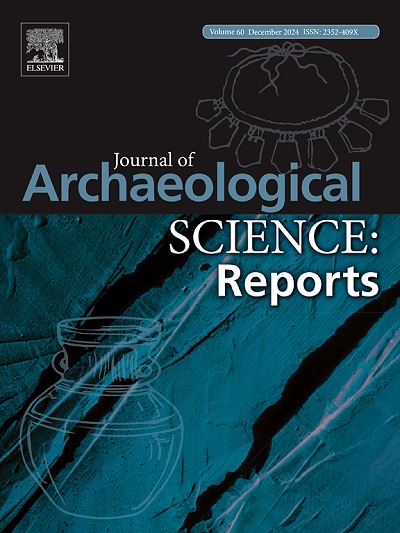基于EDXRF的考古黑曜岩物源无损分析方法——以日本北海道黑曜岩为例
IF 1.5
2区 历史学
0 ARCHAEOLOGY
引用次数: 0
摘要
我们提出了一种定量的、非破坏性的方法,用于分析黑曜石人工制品的来源,使用能量色散x射线荧光(EDXRF),基于长崎大学进行的分析。通过波长色散x射线荧光(WDXRF)和激光烧蚀-电感耦合等离子体质谱(LA-ICP-MS)分析,建立了北海道12个产地48个地质黑曜岩样品的参考数据集。采用校准曲线和康普顿散射内标法,以北海道参考数据集为校准标准,进行定量EDXRF分析。黑曜石样品实验复制品的测量结果表明,Rb、Zr、100×Rb/(Rb + Sr + Y + Zr)、100×Sr/(Rb + Sr + Y + Zr)、100×Y/(Rb + Sr + Y + Zr)和T-Fe2O3/MnO值是无损EDXRF分析的稳定可靠指标。通过将本研究的WDXRF、EDXRF和便携式x射线荧光(pXRF)数据与先前发表的数据相结合,构建了判别图,以支持北海道黑曜石的物源分析。这里开发的方法可以根据定量EDXRF数据可靠地识别考古黑曜石文物的来源。随着校准标准的进一步完善和来自日本列岛及其他地区的参考样本的纳入,这种方法可以扩展到更广泛的地区,有助于对涉及黑曜石使用的史前人类活动的考古研究。本文章由计算机程序翻译,如有差异,请以英文原文为准。
Non-destructive method of archaeological obsidian provenance analysis using EDXRF: A case study of obsidian in Hokkaido, Northern Japan
We present a quantitative, non-destructive method for analysing the provenance of obsidian artefacts using energy-dispersive X-ray fluorescence (EDXRF), based on analyses performed at Nagasaki University. We developed a reference dataset of 48 geological obsidian samples from 12 sources in Hokkaido through wavelength-dispersive X-ray fluorescence (WDXRF) and laser ablation–inductively coupled plasma–mass spectrometry (LA–ICP–MS) analysis. Quantitative EDXRF analysis was performed using the calibration curve and Compton scatter internal standard methods, with the Hokkaido reference dataset serving as calibration standards. Measurements of experimental replicas of obsidian artefacts demonstrated that Rb, Zr, 100×Rb/(Rb + Sr + Y + Zr), 100×Sr/(Rb + Sr + Y + Zr), 100×Y/(Rb + Sr + Y + Zr), and T-Fe2O3/MnO values are stable and reliable indicators for non-destructive EDXRF analysis. By integrating the WDXRF, EDXRF, and portable X-ray fluorescence (pXRF) data from this study with previously published data, we constructed discrimination diagrams to support the provenance analysis of Hokkaido obsidian. The method developed here enables reliable identification of the provenance of archaeological obsidian artefacts based on quantitative EDXRF data. With the further refinement of calibration standards and the incorporation of reference samples from across the Japanese archipelago and beyond, this approach can be extended to a broader area, contributing to archaeological research on prehistoric human activity that involved obsidian use.
求助全文
通过发布文献求助,成功后即可免费获取论文全文。
去求助
来源期刊

Journal of Archaeological Science-Reports
ARCHAEOLOGY-
CiteScore
3.10
自引率
12.50%
发文量
405
期刊介绍:
Journal of Archaeological Science: Reports is aimed at archaeologists and scientists engaged with the application of scientific techniques and methodologies to all areas of archaeology. The journal focuses on the results of the application of scientific methods to archaeological problems and debates. It will provide a forum for reviews and scientific debate of issues in scientific archaeology and their impact in the wider subject. Journal of Archaeological Science: Reports will publish papers of excellent archaeological science, with regional or wider interest. This will include case studies, reviews and short papers where an established scientific technique sheds light on archaeological questions and debates.
 求助内容:
求助内容: 应助结果提醒方式:
应助结果提醒方式:


